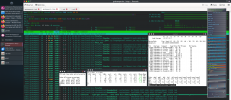Hi,
I installed FreeBSD 14 on an older HP Probook 4540S laptop with 8GB RAM, and hardware-wise everything was recognized and works well. FreeBSD is the only operating system on the laptop, so I used the whole drive for ZFS. I'm thinking about whether it's a good idea to decrease the ARC value a bit. The sysutils/zfs-stats shows me this information, from which I interpret that the maximum value is around 6.83GB:
This laptop is strictly for regular desktop use with Xfce. Occasionally, I take a ZFS snapshot, but that's pretty much everything I use from ZFS for now. Do you think it would be okay to reduce the ARC, considering I only have 8GB of RAM? I would appreciate any suggestions. Thank you.
Zoltan
I installed FreeBSD 14 on an older HP Probook 4540S laptop with 8GB RAM, and hardware-wise everything was recognized and works well. FreeBSD is the only operating system on the laptop, so I used the whole drive for ZFS. I'm thinking about whether it's a good idea to decrease the ARC value a bit. The sysutils/zfs-stats shows me this information, from which I interpret that the maximum value is around 6.83GB:
sh:
ARC Size: 14.82% 1.01 GiB
Target Size: (Adaptive) 15.40% 1.05 GiB
Min Size (Hard Limit): 3.58% 250.64 MiB
Max Size (High Water): 27:1 6.83 GiB
Compressed Data Size: 869.34 MiB
Decompressed Data Size: 1.68 GiB
Compression Factor: 1.98This laptop is strictly for regular desktop use with Xfce. Occasionally, I take a ZFS snapshot, but that's pretty much everything I use from ZFS for now. Do you think it would be okay to reduce the ARC, considering I only have 8GB of RAM? I would appreciate any suggestions. Thank you.
Zoltan




